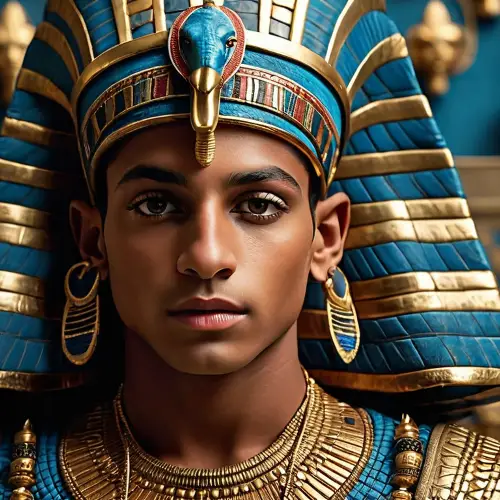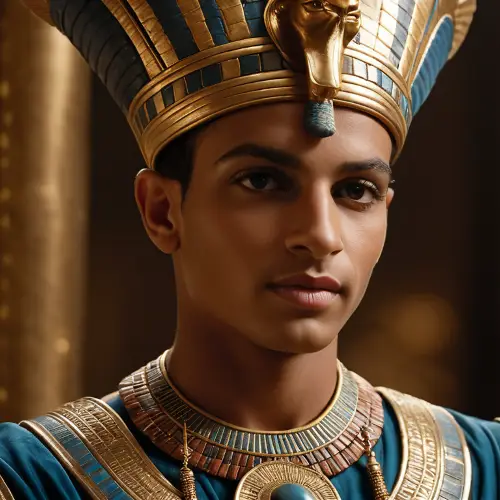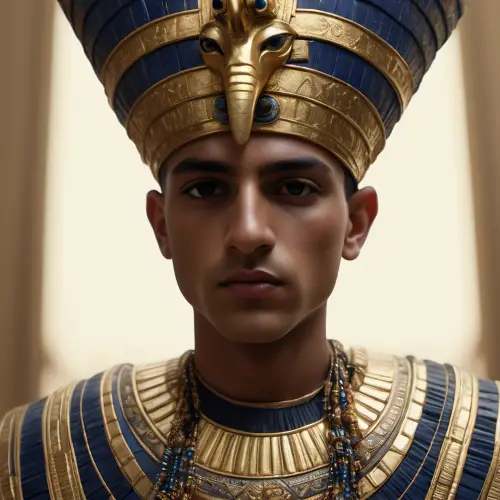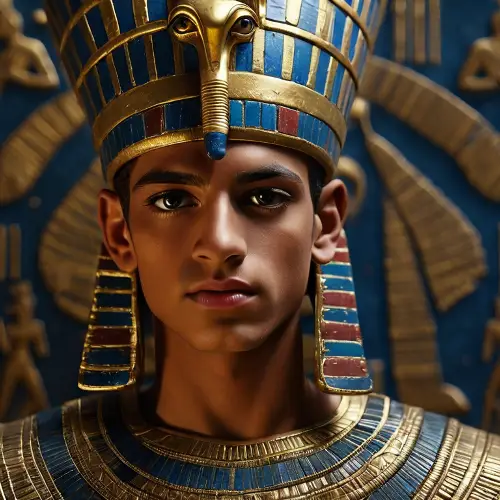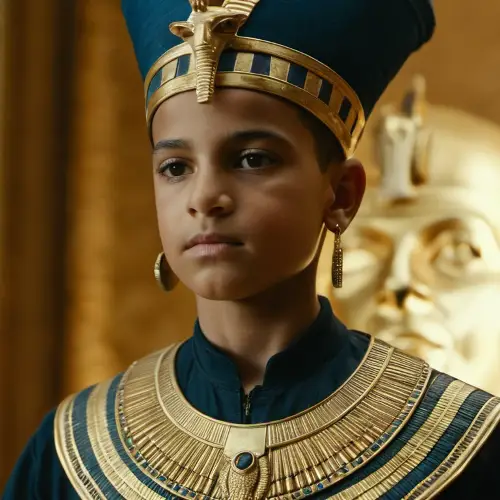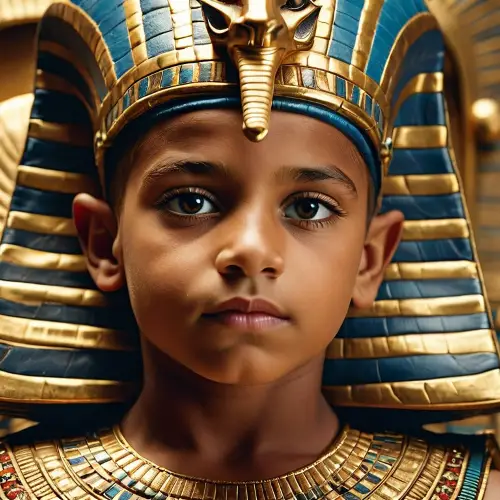Tutankhamun with distorted feet and pelvis due to a genetic disorder. In a solemn depiction, the pharaoh exhibits the effects of his inherited condition, showcasing distorted feet and a misshapen pelvis. The scene captures the challenges he faced with grace in the context of his royal role.
More Like This
Tutankhamun using a cane due to distorted feet and pelvis caused by a genetic disorder. In a poignant scene, the pharaoh is portrayed relying on a cane for support, emphasizing the impact of his inherited condition. The regal figure perseveres, symbolizing strength amid physical challenges.
Tutankhamun using a cane due to distorted feet and pelvis caused by a genetic disorder. In a poignant scene, the pharaoh is portrayed relying on a cane for support, emphasizing the impact of his inherited condition. The regal figure perseveres, symbolizing strength amid physical challenges.
Tutankhamun using a cane due to distorted feet and pelvis caused by a genetic disorder. In a poignant scene, the pharaoh is portrayed relying on a cane for support, emphasizing the impact of his inherited condition. The regal figure perseveres, symbolizing strength amid physical challenges.
Tutankhamun using a cane due to distorted feet and pelvis caused by a genetic disorder. In a poignant scene, the pharaoh is portrayed relying on a cane for support, emphasizing the impact of his inherited condition. The regal figure perseveres, symbolizing strength amid physical challenges.
Tutankhamun with a congenital genetic disorder. In a regal setting, the young pharaoh is depicted with a frail physique, illustrating the impact of his congenital condition. Advisors and attendants observe, reflecting the challenges Tutankhamun faced due to his weakened health.
A youthful Tutankhamun, Pharaoh of Egypt, portrayed in his early years. He stands with regal grace, adorned in ornate garments reflecting the opulence of ancient Egyptian royalty. The intricate details of his attire and the grandeur of his headdress symbolize the power and splendor of his reign.
A youthful Tutankhamun, Pharaoh of Egypt, portrayed in his early years. He stands with regal grace, adorned in ornate garments reflecting the opulence of ancient Egyptian royalty. The intricate details of his attire and the grandeur of his headdress symbolize the power and splendor of his reign.
Tutankhamun's mummy undergoes a meticulous analysis revealing a fractured left knee and evidence of head trauma, providing insight into the physical challenges he endured. The scene portrays the delicate examination process, emphasizing the details of the injuries.
Tutankhamun's mummy undergoes a detailed analysis, revealing a fractured left knee and signs of head trauma. The scene depicts the careful examination, highlighting the injuries on his knee and head.
Tutankhamun contracting malaria. In a dimly lit chamber, the young pharaoh shows signs of illness as he battles the effects of malaria. His weakened figure lies on an ornate bed, surrounded by concerned figures examining his symptoms, highlighting the historical struggle with the disease.
Tutankhamun seated on the throne. In a regal setting, the young pharaoh exudes authority, adorned with royal attire and the symbols of power. The scene captures the essence of his reign as he sits majestically on the throne.
Tutankhamun seated on the throne. In a regal setting, the young pharaoh exudes authority, adorned with royal attire and the symbols of power. The scene captures the essence of his reign as he sits majestically on the throne.
Pharaoh Tutankhamun adorned in a golden crown, wearing a symbolic cobra-shaped headdress embracing his shoulders. His face depicted with intricate eyeliner, a thick beard, and smooth skin. Clad in a lavish golden garment that drapes his body.
A vivid portrayal of Pharaoh Tutankhamun reigning over Egypt from 1334 BC to 1325 BC. The scene includes the Pharaoh's regal presence and the diverse populace of Egypt.
Archaeologists extract DNA from Tutankhamun's mummy inside his tomb for analysis. They collect blood and tissues, examining Tutankhamun's genetic code to understand possible genetic conditions and familial relationships.
Pharaoh Tutankhamun, the 10th ruler of Egypt's 18th dynasty, depicted in his majestic regalia, adorned with the traditional Egyptian crown and intricate jewelry. The young pharaoh, known for his reign during the New Kingdom, stands with an air of royal authority, symbolizing the grandeur of ancient Egypt.
Pharaoh Tutankhamun, the 10th ruler of Egypt's 18th dynasty, depicted in his majestic regalia, adorned with the traditional Egyptian crown and intricate jewelry. The young pharaoh, known for his reign during the New Kingdom, stands with an air of royal authority, symbolizing the grandeur of ancient Egypt.
Pharaoh Tutankhamun, the 10th ruler of Egypt's 18th dynasty, depicted in his majestic regalia, adorned with the traditional Egyptian crown and intricate jewelry. The young pharaoh, known for his reign during the New Kingdom, stands with an air of royal authority, symbolizing the grandeur of ancient Egypt.
An artistic representation of Pharaoh Tutankhamun reigning over Egypt from 1334 BC to 1325 BC.
An artistic representation of Pharaoh Tutankhamun reigning over Egypt from 1334 BC to 1325 BC.
Archaeologists uncover Tutankhamun's mummy inside his tomb, revealing the condition of the mummy and the intricacies of the golden mask covering his face. They express awe at the preservation of the mummy and meticulously examine Tutankhamun's face and body, discovering any wounds or signs of infection.
Archaeologists uncover Tutankhamun's mummy inside his tomb, revealing the condition of the mummy and the intricacies of the golden mask covering his face. They express awe at the preservation of the mummy and meticulously examine Tutankhamun's face and body, discovering any wounds or signs of infection.
Tutankhamun issuing commands from the throne. In a commanding stance, the pharaoh directs with authority, surrounded by an air of regality. The scene captures the essence of leadership as Tutankhamun rules from his throne.
Tutankhamun, ascending to the throne at the age of 9, dons the regal attire of an Egyptian pharaoh, his youthful visage illuminated by the ancient splendor of Egypt.
When Tutankhamun is alive, the scene where he wears a mask and attends the succession ceremony. The collars of Nemes on both sides of the mask represent the authority of the pharaoh, and the cobras and eagles on the foreheads symbolize the goddesses of Egypt and the Sanga.
Illustrating the mystery surrounding Tutankhamun's death, envision the young pharaoh lying peacefully in his burial chamber, surrounded by the treasures of his reign. The dim glow of flickering torches reveals the intricate details of his funeral mask, symbolizing both regality and the journey to the afterlife. An air of solemnity lingers as historians ponder the secrets concealed within the ancient tomb.
Tutankhamun's two daggers,Sharp and gleaming,Adorned with golden embellishments,Symbolizing the power of kings.A legend in history,Preserving the glory of Egypt,With grace and elegance,Instilling awe.Capture through my camera,Detailing meticulously,The radiant light and shadows,In the moment with Tutankhamun.
The discovery of the ancient mummy of Tutankhamun unfolds. As the archaeologists carefully unveil the layers of linen and wrappings, the preserved features of the young Pharaoh emerge, showcasing the artistry of ancient Egyptian embalming. The dimly lit chamber adds an aura of mystery and reverence to the moment.
The discovery of the ancient mummy of Tutankhamun unfolds. As the archaeologists carefully unveil the layers of linen and wrappings, the preserved features of the young Pharaoh emerge, showcasing the artistry of ancient Egyptian embalming. The dimly lit chamber adds an aura of mystery and reverence to the moment.
Archaeologists discovering the mummy of Tutankhamun within his tomb. They marvel at the condition and preservation of the mummy, examining its face and body. One lifts the golden mask covering the mummy's face, while another identifies wounds and signs of infection on Tutankhamun's body.
Discovery of 130 canes belonging to Tutankhamun. Archaeologists uncover a remarkable scene in the tomb, revealing a multitude of canes—each telling a unique story of the pharaoh's journey with his physical challenges. The artifacts are arranged in a carefully curated display, shedding light on Tutankhamun's reliance on these aids.












